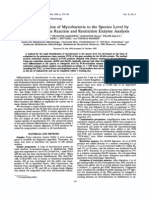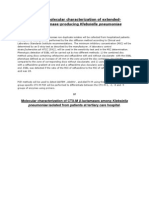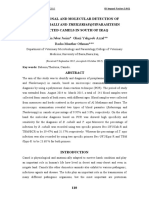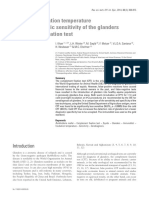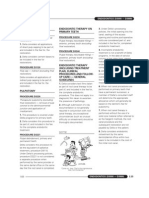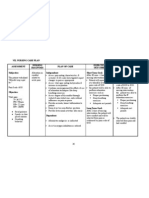Article1380528217 - Jamshidi Et Al
Article1380528217 - Jamshidi Et Al
Uploaded by
Melih BayarCopyright:
Available Formats
Article1380528217 - Jamshidi Et Al
Article1380528217 - Jamshidi Et Al
Uploaded by
Melih BayarOriginal Title
Copyright
Available Formats
Share this document
Did you find this document useful?
Is this content inappropriate?
Copyright:
Available Formats
Article1380528217 - Jamshidi Et Al
Article1380528217 - Jamshidi Et Al
Uploaded by
Melih BayarCopyright:
Available Formats
African Journal of Microbiology Research Vol. 5(26), pp. 4588-4591, 16 November, 2011 Available online at http://www.academicjournals.
org/AJMR ISSN 1996-0808 2011 Academic Journals DOI: 10.5897/AJMR11.667
Full Length Research Paper
Quantification of Escherichia coli O157:H7 in milk by most probable number polymerase chain reaction (MPN-PCR) method
Jamshidi A.1*, Mohammadi S.2 and Mohammadi A.3
Department of Food Hygiene, School of Veterinary Medicine, Ferdowsi University of Mashhad, Iran. Department of Veterinary Medicine, Faculty of Veterinary Medicine Ferdowsi University of Mashhad, Iran. 3 Department of Veterinary Biotechnology, Faculty of Veterinary Medicine Ferdowsi University of Mashhad, Iran.
2 1
Accepted 22 September, 2011
Escherichia coli O157:H7 has been recognized as one of the most important causes of potentially lifethreatening human diseases such as haemorrhagic colitis, haemolytic ureamic syndrome and thrombotic thrombocytopenic purpura. To combine the principles of most-probable-number (MPN) statistics and the conventional polymerase chain reaction (PCR) technique to enumerate E. coli 1 5 -1 O157:H7 in milk, from 10 to 10 ml of bacterial cells were inoculated in sterilized milk. Different background microorganisms including Gram positive and Gram negative bacteria were also inoculated. Modified MPN dilutions from inoculated milk sample with three replicates per dilution were prepared and enumeration was performed by DNA extraction from tubes showing turbidity and performing multiplex-PCR (m-PCR) using primers specific for O157 and H7 antigens gene. This MPN-PCR proved to 1 -1 be a rapid and reliable method for enumerating E. coli O157:H7 in milk at the lowest level (10 cfu.ml ), even in the presence of different Gram positive and Gram negative background microorganisms. It may facilitate the enumeration of E. coli O157:H7 for routine analyses in milk without excessive work and could be considered as an alternative to MPN- culture techniques. Key words: E. coli O157:H7, milk, most probable number-polymerase chain reaction (MPN-PCR), most probable number (MPN) - culture, multiplex- polymerase chain reaction (m-PCR). INTRODUCTION Verocytotoxin-producing Escherichia coli (VTEC) strains are the most important recently emerged food-borne pathogens (Armstrong et al., 1996). VTEC may belong to many serotypes, but most severe human infections are caused by strains of E. coli O157:H7 (Mead and Griffin, 1998). E. coli O157:H7 causes haemorrhagic colitis, hemolytic-ureamic syndrome and thrombotic thrombocytopenic purpura (Zhao et al., 1998). Cattle frequently excrete these bacteria in their feces (Molina et al., 2003; Van Donkersgoed et al., 1999). Since dairy cattle are asymptomatic carriers (Heuvelink et al., 1998) of E. coli O157:H7, milk products are thought to be risky foods. Therefore insufficient heat-treatment of raw milk forms a potential infection risk (Betts, 2000). Cheese made with unpasteurised milk is potential vehicle for transmission of E. coli O157:H7 to the consumers (Oksuz et al., 2004). The specific identification of E. coli O157:H7 based on culture and biochemical methods is laborious and time consuming and in food products takes 5 or more days to complete (Oberst et al., 1998). Furthermore, other than the culture methods which are based on biochemical characteristics of the bacteria, many other assays have been developed, including serological techniques, which uses both polyclonal and monoclonal antibodies specific for the O and H antigens (Kimura et al., 2000). Molecular approaches have also been practiced. In this regards, polymerase chain reaction (PCR) assays based on the presence or absence of specific genes such as the stx, eaeA and hlyA have been described (Kimura et al., 2000; Pilpott and Ebel, 2003).
*Corresponding author. E-mail: ajamshid@ferdowsi.um.ac.ir. Tel: 0511-8788944. Fax: 0511-8763852.
Jamshidi et al.
4589
Table 1. Primers and predicted product size for Escherichia coli O157: H7.
Target gene rfbO157
Primer sequence(name) F: 5- CGG ACA TCC ATG TGA TAT GG -3 R: 5- TTG CCT ATG TAC AGC TAA TCC -3 F: 5- GCG CTG TCG AGT TCT ATC GAG-3 R: 5- CAA CGG TGA CTT TAT CGC CAT TCC-3
Predicted product size(bp) 259
flicH7
625
However, most of them require a selective enrichment step and consequently, absence or presence can be determined, such results, are meaningless in terms of quantification (Hussein et al., 2002). Most probable number- polymerase chain reaction (MPN-PCR) method have been described previously for enumeration of micro-organisms in soil (Fredslund et al., 2001), water (Savill et al., 2001) and foods (Mantynen et al., 1997; Miwa et al., 1999; Jeyaletchumi et al., 2010). Overall, this method was found to be a rapid and reliable method that could facilitate the enumeration of different micro-organisms. In the present study, we enumerated the inoculated E. coli O157:H7 in milk samples with the combination of the MPN method and the species-specific PCR targeting the somatic and flagellar antigen gene, to evaluate the sensitivity and specificity of the method.
MATERIALS AND METHODS Bacterial reference strain In this study E. coli O157:H7 (ATCC-35150) purchased from Mast International Inc, was used for the experiment.
microorganisms were performed the same way as for reference strain.
MPN-PCR procedure Amount of 10, 1, 0.1, 0.01 and 0.001 ml of each milk sample containing 101 to 105 cells-ml -1 of E. coli O157:H7 and 103 cells-ml 1 of background microorganisms with three replicates per dilution were inoculated in tubes containing 10 ml of modified trypticase soy broth (m-TSB) with 20 mgL-1 novobiocin, double strength medium was prepared for testing 10 ml quantities of samples. Inoculated tubes were incubated at 37 C for 24 h. In order to ob tain the most reliable results, three consecutive dilutions which were positive at lower dilutions and negative at higher dilutions were selected for computing the MPN. In order to perform multiplex-PCR, the DNA extraction were performed from tubes showing visible turbidity, using phenolchloroform DNA extraction method (Simon et al., 1996). The sequence of the two pairs of primers are shown in Table 1. The flic H7 primers are specific for the flagellar antigen (H7), and rfb 0157 primers are specific for somatic antigen (O157) (Pilpott and Ebel, 2003; Desmarchier et al., 1998). The m-PCR reaction were performed in a 25 l amplification mixture consisting of 2.5 l of 10 PCR buffer (500 mM KCl, 200 mM Tris HCl), 0.5 l dNTPs (10 mM), 1 l Mg Cl2 (50 mM), 1.25 l of each primer (0.5 M) , 0.2 l of Taq DNA polymerase (5 unit/l) and 2 microliter of template. The thermocycler (Bio Rad) program was started with initial incubation at 94 C for 5 m in, followed by 35 cycles of denaturation at 94 C for 60 s, annealing at 52C for 30 s and elongation at 72C for 60 s, and final extension at 72 C for 10 min. The PCR products were separated by electrophoresis in 1.5% agarose gel at 100V for 40 min in tris-acetate buffer, visualized by ethidium bromide staining, illuminated by UV- transilluminator and documented by a gel documentation apparatus. 100 bp DNA ladder was used as a size reference for m-PCR assay. The expected size of m-PCR products for rfb O157 and flic H7 genes amplification were 259 and 625 bp, respectively. The turbid tubes which showed the expected size in m-PCR were considered as positive in computing the MPN.
Inoculation Pure cultures of E. coli O157:H7 were prepared by subculturing the test strain into 10 ml of Brain Heart Infusion Broth (Merck), following incubation at 37 C for 24 h. The concentration of th e resulting culture of E. coli O157:H7 was determined by preparing serial dilutions and viable counts by surface plating on MacConkey agar (Himedia). The absorbance of the cultured media were also determined in 600 nm wave length, using a spectrophotometer apparatus (Jenway 6105, Essex, England), in order to inoculate the same dose of bacteria in repeating the experiment. To combine the principles of most probable number (MPN) statistics and the conventional PCR technique to enumerate E. coli O157:H7, sterilized milk were used as matrix, and 101 to 105 cellsml -1 of the reference strain were inoculated. A variety of Gram positive and Gram negative background microorganisms including: Staphylococcus aureus (ATCC-25923), Bacillus cereus (ATCC- 10876), Clostridium perfringenes (ATCC13124), Listeria monocytogenes (ATCC- 7644), Salmonella typhimurium (ATCC- 14028) and Campylobacter jejuni (ATCC33291) were grown in appropriate broth media and number of 103 bacterial cells were inoculated. Enumeration of background
RESULTS In order to enumerate the inoculated E. coli O157:H7 in sterilized milk samples, the modified MPN method whit five dilution and three replicates per each dilution with the -2 5 detection limit of < 310 /100 ml to >2.410 /100 ml were used, then the DNA extraction and m-PCR assay from turbid tubes were performed using specific primers for somatic and flagellar antigens gene. The method
4590
Afr. J. Microbiol. Res.
11
10
Figure 1. Results of the PCR assay, amplifying 259 base pair segment of rfbO157 and 625 base pair of flicH7 gene of E. coli O157: H7. Lane 1: 100bp marker. Lane2: positive control. Lane 3: negative control. Lanes 4-11: positive samples.
could accurately enumerate the inoculated E. coli O157:H7 in sterilized milk samples at the lowest level 1 1 (10 cfu.ml ), even in the presence of different Gram positive and Gram negative background microorganisms (Figure 1). The sensitivity of the method determined as -1 enumeration of 10 cfu.ml and it's specificity as 100%. DISCUSSION Numerous modern methods have been developed for the quantification of E. coli O157:H7 such as real-time PCR (Ibekwe and Grieve, 2003) and flow cytometry (Hussein et al., 2002). However, these methods are, in general, too expensive and not suitable for routine analysis in many laboratories. PCR detection methods have been extensively used in diagnostic microbiology. However, a lack of a simple and reliable method for quantification of the PCR products has partly hindered the use of PCR in routine food laboratories. The quantification of PCR products can be done by combining the principles of MPN statistics and PCR technique (Mantynen et al., 1997). It seems that direct plating of tubes with turbidity on CT-SMAC agar (MPN-culture method) is not an appropriate method for the enumeration of E. coli O157:H7 in milk samples, since the plates may be covered by a slime of other micro-organisms. It has been reported that the MPN-PCR method may be more convenient and reliable than the MPN-culture method, especially for samples that show many colonies other than the target bacterial colonies. Furthermore, utilization of the PCR technique reduces the time and labor required for the biochemical identification tests used in the MPN-culture method (Miwa et al., 2003). The major inconveniences of the MPN method coupled with traditional confirmation techniques are the amount of material, the workload, and above all, the time needed to complete identification (4 to 5 days). However using
chromagar could be cost-effective and reduces the number of some biochemical and serological tests (Church et al., 2007). The combination of MPN method with a species-specific PCR method enables the completion of enumeration within 2 days. The MPN-PCR method could facilitate the enumeration of E. coli O157:H7 in milk samples without the interference of background micro-organisms, because of using specific primers to somatic (O157) and flagellar (H7) antigens gene. The use of m-TSB broth as the culture medium avoids the most undesirable micro-organisms and permits the growth of E. coli O157:H7. Although PCR appears to be the most sensitive and rapid option, but it should be noticed that some food or enrichment medium components can inhibit the reaction, substances which have been proved to be PCR inhibitory such as calcium ions in milk (Bickley et al., 1996), and proteinases (Powell et al., 1994), haem compounds (Akane et al., 1994), chelating agents, and proteins may be present in other foods (Rossen et al., 1992; Aymerich et al., 2003). Inhibition of PCR may be overcome by sample preparation using dilution, centrifugation, filtration, aqueous two-phase systems, adsorption methods, DNA extraction (Lantz et al., 1994), and Chelex or EGTA treatment of the sample (Bickley et al., 1996). Picozzi et al. (2004) reported that MPN-PCR showed values of relative accuracy, sensitivity and specificity of, respectively, 85.8, 81.6 and 93.5% in enumeration of E. coli in minced meat, using primers specific for the uidA gene. In this study for detection and enumeration of E. coli O157:H7 serotype, we used specific primers. Considering the presence of different background microorganisms the method showed the specificity of 100% and it's sensitivity determined as enumeration of 10 -1 cfu.ml (the lowest level of inoculation). It seems that the MPN-PCR method, using the specified primers, is a convenient and reliable method for enumeration of E. coli O157:H7 in milk samples, and could be considered as an
Jamshidi et al.
4591
alternative to MPN- culture techniques.
REFERENCES Akane A, Matsubara K, Nakamura H, Takahashi S, Kimura K (1994). Identification of the heme compound copurified with deoxyribonucleic acid (DNA) from bloodstains, a major inhibitor of polymerase chain reaction (PCR) amplification. J. Forensic Sci., 39: 362372. Armstrong GL, Hollingsworth J, Morris Jr JG (1996). Emerging foodborne pathogens: Escherichia coli O157:H7 as a model of entry of a new pathogen into the food supply of the developed world. Epidemiol Rev., 18: 2951. Aymerich T, Martin B, Garriga M, Hugas M (2003). Microbial quality and direct PCR identification of lactic acid bacteria and non-pathogenic staphylococci from artisanal low-acid sausages. Appl. Environ. Microbiol., 69: 45834594. Betts GD (2000). Controlling E. coli O157:H7. Nutr. Food Sci., 30(4): 183186. Bickley J, Short JK, McDowell DG, Parkes HC (1996). Polymerase chain reaction (PCR) detection of Listeria monocytogenes in diluted milk and reversal of PCR inhibition caused by calcium ions. Lett. Appl. Microbiol., 22: 153158. Church DL, Emshey D, Semeniuk H, Lloyd T, Pitout JD (2007). Evaluation of BBL CHROMagar O157 versus Sorbitol-MacConkey Medium for Routine Detection of Escherichia coli O157 in a Centralized Regional Clinical Microbiology Laboratory. J. Clin. Microbiol., 45: 30983100. Desmarchier P M, Bilge SS, Fegan N, Mills L, Vary JC, Tarr PI (1998). A PCR specific for Escherichia coli O157: H7 Based on rfb locus encoding O157 lipopolysaccharide. J. Clin. Microbiol., 36: 1801-1804. Fredslund L, Ekelund F, Jacobsen CS, Johnsen K (2001). Development and application of a most-probable-number-PCR assay to quantify flagellate populations in soil samples. Appl. Environ. Microbiol., 67: 16131618. Heuvelink AE, van den Biggelarr FL, Zwartkruis-Nahuis J, Herbes RG, Huyben R, Nagelkerke N, Melchers WJ, Monnes LA, de Boer E (1998).Occurrence of verocytotoxin producing Escherichia coli O157 on Dutch dairy farms. J. Clin. Micribiol., 36: 34803487. Hussein HS, Thran BH, Redelman D (2002). Detection of Escherichia coli O157:H7 in bovine rumen fluid and feces by flow cytometry. Food Control, 13: 387391. Ibekwe AM, Grieve CM (2003). Detection and quantification of Escherichia coli O157:H7 in environmental samples by real-time PCR. J. Appl. Microbiol., 94: 421431. Jeyaletchumi P, Tunung R, Margaret SP, Son R, Ghazali FM, Cheah YK, Nishibuchi M, Nakaguchi Y, Malakar PK (2010). Quantification of Listeria monocytogenes in salad vegetables by MPN-PCR. Int. Food Res. J., 17: 281-286 Kimura R, Mandrell RE, Galland JC, Hyatt D, Riley LW (2000). Restriction-site-specific PCR as a rapid test to detect enterohemorrhagic Escherichia coli O157: H7 strains in environmental samples., Appl. Environ. Microbiol., 66: 2513-2519. Lantz PG, Hahn-Hagerdal B, Radstrom P (1994). Sample preparation methods in PCR-based detection of food pathogens., Trends Food Sci. Tech., 5: 384389. Mantynen V, Niemel S, Kaijalainen S, Pirhonen T, Lindstrm K (1997). MPN-PCR-quantification method for staphylococcal enterotoxin c 1 gene from fresh cheese. Int. J. Food Microbiol., 36: 135-143. Mead PS, Griffin PM (1998). Escherichia coli O157:H7. Lancet 352: 1207 1212. Miwa N, Masuda T, Terai K, Kawamura A, Otani K, Miyamoto H (1999). Bacteriological investigation of an outbreak of Clostridium perfringens food poisoning caused by Japanese food without animal protein. Int. J. Food Microbiol., 49: 103106. Miwa N, Nishio T, Arita Y, Kawamori F, MasudaT, Akiyama M (2003). Evaluation of MPN Method Combined with PCR Procedure for Detection and Enumeration of Vibrio parahaemoluticus in Seafood. J. Food Hyg. Soc. Japan, 44: 289-293. Molina PM, Parma AE, Sanz ME (2003). Survival in acidic and alcoholic medium of shiga toxin-producing Escherichia coli O157: H7 and nonO157: H7 isolates in Argentina. BMC Microbiol., 13: 3-17. Oberst RD, Hays MP, Bohra K, Phebus RK, Yamashiro CT, PaszkoKolva C, Flood SJA, Sargeant JM, Gillespie JR (1998). PCR-Based DNA Amplification and Presumptive Detection of Escherichia coli O157:H7 with an Internal Fluorogenic Probe and the 59 Nuclease (TaqMan) Assay. Appl. Environ. Microbiol., 64: 3389-3396. Oksuz O, Arici M, Kurultay S, Gumus T (2004). Incidence of Escherichia coli O157: H7 in raw milk and white pickled cheese manufactured from raw milk in Turkey. Food Control, 15: 453-456. Picozzi C, Foschino R, Dipilato P (2004). Exploiting a MPN-PCR technique to quantify Escherichia coli in minced meat. Ann. Microbiol., 54: 343-349. Pilpott D, Ebel F (2003). E. coli: shigatoxin methods and protocols. 1th edn. Humana Press Inc., pp. 9-45. Powell HA, Gooding CM, Garrett SD, Lund BM, McKee RA (1994). Proteinase inhibition of the detection of Listeria monocytogenes in milk using the polymerase chain reaction. Lett. Appl. Microbiol., 18: 5961. Rossen L, Nskov P, Holmstrm K, Rasmussen OF (1992). Inhibition of PCR by components of food samples, microbial diagnostic assays and DNA-extraction solution. Int. J. Food Microbiol., 17: 3745. Savill MG, Hudson JA, Ball A, Klena JD, Scholes P, Whyte RJ, McCormick RE, Jankovic D (2001). Enumeration of Campylobacter in New Zealand recreational and drinking waters. J. Appl. Microbiol., 91: 3846. Simon MC, Gray DI, Cook N (1996). DNA Extraction and PCR Methods for the Detection of Listeria monocytogenes in Cold-Smoked Salmon. Appl. Environ. Microbiol., 62: 822-824. Van Donkersgoed J, Graham T, Gannon V (1999). The prevalence of verotoxins, Escherichia coli O157: H7 and Salmonella in the feces and rumen of cattle at processing. Can. Vet. J., 40: 332-338. Zhao T, Doyle MP, Harmon BG, Brown CA, Eric Mueller PO, Parks AH (1998). Reduction of carriage of Enterohemorrhagic Escherichia coli O157: H7 in cattle by inoculation with probiotic bacteria. J. Clini. Microbiol., 36: 641-647.
You might also like
- Histology Slides EpitheliumDocument3 pagesHistology Slides EpitheliumNourhan Jamal100% (1)
- Mouse IFN-γ ELISA KitDocument13 pagesMouse IFN-γ ELISA KitAnogenNo ratings yet
- Detection and Typing of Human Papillomaviruses by PCRDocument5 pagesDetection and Typing of Human Papillomaviruses by PCRMyat OoNo ratings yet
- A Method For The Rapid Purification of Serum IgM For The Diagnosis of Recent Viral Infections of ChickensDocument9 pagesA Method For The Rapid Purification of Serum IgM For The Diagnosis of Recent Viral Infections of ChickensnrsmartNo ratings yet
- 289generation of Recombinant Antibody Fragments Against Rep Protein of Tomato Yellow Leaf Curl Virus by Phage Display TechnologyDocument7 pages289generation of Recombinant Antibody Fragments Against Rep Protein of Tomato Yellow Leaf Curl Virus by Phage Display Technologyiyotake33No ratings yet
- Application and Evaluation of Loop Mediated IsotheDocument22 pagesApplication and Evaluation of Loop Mediated IsotheAliyi HassenNo ratings yet
- CMJ 55 3 Kit 24891284Document6 pagesCMJ 55 3 Kit 24891284Mihaela-Alexandra PopNo ratings yet
- Rapid Identification ..Document4 pagesRapid Identification ..Nithyakalyani AsokanNo ratings yet
- Quantitative-PCR Assessment of Cryptosporidium Parvum Cell Culture InfectionDocument6 pagesQuantitative-PCR Assessment of Cryptosporidium Parvum Cell Culture InfectionRodolfo Graña ArrospideNo ratings yet
- Detection of Pig Derivatives in Food Products For Halal Authentication by Polymerase Chain Reaction-Restriction Fragment Length PolymorphismDocument4 pagesDetection of Pig Derivatives in Food Products For Halal Authentication by Polymerase Chain Reaction-Restriction Fragment Length Polymorphismmasyitah.amat18No ratings yet
- Aa Aa Aaaaaa: Int. J. Mol. Sci. 2016, 17 (5), 624 Doi: ArticleDocument22 pagesAa Aa Aaaaaa: Int. J. Mol. Sci. 2016, 17 (5), 624 Doi: ArticleAri IndrawatiNo ratings yet
- Sandwich ELISADocument6 pagesSandwich ELISAMariatul QibtiyahNo ratings yet
- 938 FullDocument5 pages938 FullDiana ElamNo ratings yet
- ParasitDocument7 pagesParasitRainz BlackNo ratings yet
- Prevalence of Enterotoxigenic Clostridium Perfringens in Meats in San Luis, ArgentinaDocument6 pagesPrevalence of Enterotoxigenic Clostridium Perfringens in Meats in San Luis, Argentinamauro manfrediNo ratings yet
- Sreening and Qualification of AntibioticsDocument16 pagesSreening and Qualification of AntibioticsGodwin KingsleyNo ratings yet
- 1 - Detection of Hemolysins in AeromonasDocument11 pages1 - Detection of Hemolysins in AeromonasandymicdNo ratings yet
- Refined Preparation and Use of Anti-Diglycine Remnant (K-Quantification of 10,000s of Ubiquitination Sites in Single Proteomics ExperimentsDocument7 pagesRefined Preparation and Use of Anti-Diglycine Remnant (K-Quantification of 10,000s of Ubiquitination Sites in Single Proteomics ExperimentsArranegiko FarerasNo ratings yet
- Citotoxic CAPEDocument8 pagesCitotoxic CAPEannisa_yuniartiNo ratings yet
- Development of Anti-Peptide Polyclonal Antibodies Raised Against Immunogenic Sequences of Protein Encoded by Fj194940.1 GeneDocument9 pagesDevelopment of Anti-Peptide Polyclonal Antibodies Raised Against Immunogenic Sequences of Protein Encoded by Fj194940.1 GeneijsidonlineinfoNo ratings yet
- Detection Of: Samples by The Combination of Immunomagnetic Separation and PCR AssayDocument5 pagesDetection Of: Samples by The Combination of Immunomagnetic Separation and PCR AssayfrankyNo ratings yet
- 1-Eastern Mediterranean Health JournalDocument5 pages1-Eastern Mediterranean Health Journalreadyboy89No ratings yet
- tmp46BD TMPDocument5 pagestmp46BD TMPFrontiersNo ratings yet
- Biores 2012 0241Document5 pagesBiores 2012 0241Anonymous JXKgWBjerNo ratings yet
- Development of Real-Time PCR For The Detection of Clostridium Perfringens in Meats and VegetablesDocument5 pagesDevelopment of Real-Time PCR For The Detection of Clostridium Perfringens in Meats and VegetablesGuilhermeNo ratings yet
- Anti-Cancer Activity of Silymarin On MCF-7 and NCIH-23 Cell LinesDocument5 pagesAnti-Cancer Activity of Silymarin On MCF-7 and NCIH-23 Cell LineshameedhaaNo ratings yet
- Method: Prevalence and molecular characterization of extended-spectrum β-lactamase-producing Klebsiella pneumoniaeDocument4 pagesMethod: Prevalence and molecular characterization of extended-spectrum β-lactamase-producing Klebsiella pneumoniaeAnupa PokhrelNo ratings yet
- Effect of Antibodies On The Expression of Plasmodium Falciparum Circumsporozoite Protein GeneDocument4 pagesEffect of Antibodies On The Expression of Plasmodium Falciparum Circumsporozoite Protein Genereza gomaNo ratings yet
- Antiestrogenic Activities of Cimicifuga Racemosa ExtractsDocument6 pagesAntiestrogenic Activities of Cimicifuga Racemosa ExtractsPrashant YadavNo ratings yet
- Methodsx: Leen Janssen, Frank Sobott, Peter P. de Deyn, Debby Van DamDocument12 pagesMethodsx: Leen Janssen, Frank Sobott, Peter P. de Deyn, Debby Van DamMia AisyahNo ratings yet
- Semi-Automated Fluorogenic PCR Assays (TaqMan) Forrapid Detection of Escherichia Coli O157H7 and Other Shiga Toxigenic E. Coli 1999Document12 pagesSemi-Automated Fluorogenic PCR Assays (TaqMan) Forrapid Detection of Escherichia Coli O157H7 and Other Shiga Toxigenic E. Coli 1999Ahmed BelhadriNo ratings yet
- Cattle As A Possible Source of Verocytotoxin-Producing Escherichia Coli 0157 Infections in ManDocument9 pagesCattle As A Possible Source of Verocytotoxin-Producing Escherichia Coli 0157 Infections in Manhaddig8No ratings yet
- Molecular Detection of Resistance and Virulence Genes in Coagulase Negative Staphylococci Isolated From Blood Cultures at The University Teaching Hospital of BouakeDocument11 pagesMolecular Detection of Resistance and Virulence Genes in Coagulase Negative Staphylococci Isolated From Blood Cultures at The University Teaching Hospital of BouakeSambhavNo ratings yet
- Cloning and Expression of Human Immunoglobulin G4 (Higg4) Hinge Region Cdna From Blood SampleDocument6 pagesCloning and Expression of Human Immunoglobulin G4 (Higg4) Hinge Region Cdna From Blood SampleIpank CoolerNo ratings yet
- The occurrence of AmpC β-lactamase and ESBL producing Gram-negative bacteria by a simple and convenient screening method and its suitability in routine useDocument6 pagesThe occurrence of AmpC β-lactamase and ESBL producing Gram-negative bacteria by a simple and convenient screening method and its suitability in routine useIOSRjournalNo ratings yet
- NEJM appendixPDF2020Document7 pagesNEJM appendixPDF2020Marin AndreiNo ratings yet
- 110 121 PDFDocument12 pages110 121 PDFHasn FXNo ratings yet
- 110 121 PDFDocument12 pages110 121 PDFHasn FXNo ratings yet
- Peptostreptococcus Micros: Detection of DNA in Clinical Samples by PCRDocument6 pagesPeptostreptococcus Micros: Detection of DNA in Clinical Samples by PCRjorgeNo ratings yet
- Application of Serologic Assays For DiagnosisDocument26 pagesApplication of Serologic Assays For Diagnosisms.sanna21No ratings yet
- Expression, Purification, and Activity Assay of Chicken Interferon-AlphaDocument7 pagesExpression, Purification, and Activity Assay of Chicken Interferon-AlphaBobbyGunarsoNo ratings yet
- Epidermidis Carrying Biofilm Formation GenesDocument5 pagesEpidermidis Carrying Biofilm Formation GenesLini MaliqisnayantiNo ratings yet
- Research Article: The c-MYC Protooncogene Expression in CholesteatomaDocument7 pagesResearch Article: The c-MYC Protooncogene Expression in CholesteatomaVicky G OeiNo ratings yet
- Effect of Incubation Temperature On The Diagnostic Sensitivity of The Glanders Complement Fixation TestDocument8 pagesEffect of Incubation Temperature On The Diagnostic Sensitivity of The Glanders Complement Fixation TestMuhammad SaqibNo ratings yet
- Beclin 1Document8 pagesBeclin 1Arif MohiddinNo ratings yet
- Sallerfors 1991Document9 pagesSallerfors 1991AndikhaNo ratings yet
- Cancer CellDocument7 pagesCancer CellSherlok HolmesNo ratings yet
- Koo Ken 2014Document7 pagesKoo Ken 2014Perla Andrea Urriola AraosNo ratings yet
- Antimicrobial and Antiviral Effect of High-Temperature Short-TimeDocument7 pagesAntimicrobial and Antiviral Effect of High-Temperature Short-Timeayu kristiyaningrumNo ratings yet
- Mouse TNF-α ELISA KitDocument13 pagesMouse TNF-α ELISA KitAnogenNo ratings yet
- Chloramphenicol Resistance Genes in Salmonella From Human and Animal Sources in HungaryDocument7 pagesChloramphenicol Resistance Genes in Salmonella From Human and Animal Sources in HungarydeckvondavonNo ratings yet
- Research Note- Identification and characterization of Salmonella spp. in mechanically deboned chickens using pulsed-field gel electrophoresis - PMCDocument12 pagesResearch Note- Identification and characterization of Salmonella spp. in mechanically deboned chickens using pulsed-field gel electrophoresis - PMCgsq5qqydskNo ratings yet
- Suppression of Human Immunodeficiency Virus Replication by Ascorbate in Chronically and Acutely Infected Cells.Document5 pagesSuppression of Human Immunodeficiency Virus Replication by Ascorbate in Chronically and Acutely Infected Cells.Hector Javier Chavez RamirezNo ratings yet
- Hartmeyer 2017, PCR en Parásitos.Document7 pagesHartmeyer 2017, PCR en Parásitos.planhigion06No ratings yet
- jm000191 2Document1 pagejm000191 2BobNo ratings yet
- PCR MAMA en Gyr A y Parc PDFDocument18 pagesPCR MAMA en Gyr A y Parc PDFclaudiaNo ratings yet
- J. Clin. Microbiol.-2012-Koepsell-3395-7Document4 pagesJ. Clin. Microbiol.-2012-Koepsell-3395-7Freddy A. ManayayNo ratings yet
- 68th AACC Annual Scientific Meeting Abstract eBookFrom Everand68th AACC Annual Scientific Meeting Abstract eBookNo ratings yet
- 69th AACC Annual Scientific Meeting Abstract eBookFrom Everand69th AACC Annual Scientific Meeting Abstract eBookNo ratings yet
- Staphylococcus Aureus EngDocument12 pagesStaphylococcus Aureus EngMelih BayarNo ratings yet
- Vibrio EngDocument14 pagesVibrio EngMelih BayarNo ratings yet
- Shigella EngDocument11 pagesShigella EngMelih BayarNo ratings yet
- Building Research and Development Capabilities: Chapter TwoDocument26 pagesBuilding Research and Development Capabilities: Chapter TwoMelih BayarNo ratings yet
- Erg+ N ChocolateDocument34 pagesErg+ N ChocolateMelih BayarNo ratings yet
- Ep106 2005 Mt3 Summer SchoolDocument1 pageEp106 2005 Mt3 Summer SchoolMelih BayarNo ratings yet
- Ep106 2004 Mt1 Summer SchoolDocument1 pageEp106 2004 Mt1 Summer SchoolMelih BayarNo ratings yet
- Ep106 2003 Mt3 Summer SchoolDocument1 pageEp106 2003 Mt3 Summer SchoolMelih BayarNo ratings yet
- Home Suraksha Plus - Prospectus PDFDocument4 pagesHome Suraksha Plus - Prospectus PDFamit chaudhari100% (1)
- Inguinal Hernia HydroceleDocument100 pagesInguinal Hernia HydroceleAnkurNo ratings yet
- A History of Manipulative Therapy Through The Ages and Up To The Current Controversy in The United StatesDocument13 pagesA History of Manipulative Therapy Through The Ages and Up To The Current Controversy in The United Statesliz100% (1)
- Pathogenesis of Bacterial InfectionDocument9 pagesPathogenesis of Bacterial Infectionsonyda444No ratings yet
- Abstract Book (2014)Document346 pagesAbstract Book (2014)Zakir HossainNo ratings yet
- Boost His Sex DriveDocument24 pagesBoost His Sex DriveCassie PutnamNo ratings yet
- Holden DiagnosisDocument1 pageHolden Diagnosisapi-235086601No ratings yet
- Pulp CappingDocument3 pagesPulp Cappingporsche_cruiseNo ratings yet
- Hasil Maju Poster MakasarDocument10 pagesHasil Maju Poster MakasarHari ciptadiNo ratings yet
- 240443-Article Text-579117-1-10-20230130Document13 pages240443-Article Text-579117-1-10-20230130joetonNo ratings yet
- Certificate For COVID-19 Vaccination: Beneficiary DetailsDocument1 pageCertificate For COVID-19 Vaccination: Beneficiary DetailsPiyush JindalNo ratings yet
- AnophelesDocument398 pagesAnophelesAdinda RahmaNo ratings yet
- Surgery - Orthopedic Surgery and NeurosurgeryDocument88 pagesSurgery - Orthopedic Surgery and Neurosurgeryteena6506763No ratings yet
- Glosar Sisteme de SanatateDocument341 pagesGlosar Sisteme de SanatateDiana IorgulescuNo ratings yet
- 00P 185 GEN III MicroPlate IFUDocument8 pages00P 185 GEN III MicroPlate IFUDaniela IonicaNo ratings yet
- Hepatocellular Carcinoma: T L A MDocument26 pagesHepatocellular Carcinoma: T L A MEdna Uneta RoblesNo ratings yet
- Pelvic FracturesDocument8 pagesPelvic FracturesArif AbubakarNo ratings yet
- مشروع بيانات تخطيط القلب ويكاDocument21 pagesمشروع بيانات تخطيط القلب ويكاابو العزNo ratings yet
- Drug Study NCPDocument4 pagesDrug Study NCPJustice Ace DaprozaNo ratings yet
- Physiology, Lecture 5, Respiratory System (Slides)Document43 pagesPhysiology, Lecture 5, Respiratory System (Slides)Ali Al-QudsiNo ratings yet
- Instant Download Vernacular Medicine in Colonial India Family Market and Homoeopathy Shinjini Das PDF All ChapterDocument49 pagesInstant Download Vernacular Medicine in Colonial India Family Market and Homoeopathy Shinjini Das PDF All Chapterbnsalhqishta100% (6)
- Vii. Nursing Care Plan Assessment Nursing Diagnosis Plan of Care Expected Outcome Evaluation Subjective: Independent: Short Term GoalDocument1 pageVii. Nursing Care Plan Assessment Nursing Diagnosis Plan of Care Expected Outcome Evaluation Subjective: Independent: Short Term Goalapi-3828211No ratings yet
- NCP Diabetic NephropathyDocument10 pagesNCP Diabetic NephropathyBiway RegalaNo ratings yet
- Somatoform Disorders Unit 3Document23 pagesSomatoform Disorders Unit 3Dolly GuptaNo ratings yet
- See I 005Document7 pagesSee I 005Zaireen LargaNo ratings yet
- Biomedical Perspective in Gender and SexualityDocument31 pagesBiomedical Perspective in Gender and SexualityIvy Apolinario100% (1)
- The 2018 AAPEFP Classification of Periodontal DiseDocument3 pagesThe 2018 AAPEFP Classification of Periodontal DiseClaudia RosalesNo ratings yet
- Plat-E: An Efficient and Stable System For Transient Packaging of RetrovirusesDocument5 pagesPlat-E: An Efficient and Stable System For Transient Packaging of RetrovirusesSairam06No ratings yet
- Vocational Guideline Practical FinalDocument383 pagesVocational Guideline Practical FinalramnarayandatascienceNo ratings yet







